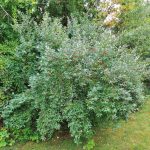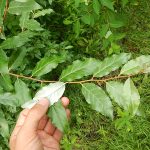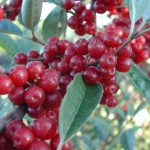Autumn Olive
Identification:
Autumn-olive is a deciduous shrub that may reach between 3 to 20 feet in height. The shrub has alternate, elliptical leaves with a silver underside. The shiny underside of the leaves is the easiest way to identify them. The bark is olive drab with many white lenticels (small lines along the bark used for gas exchange) and the branches contain many thorns. 5 to 10 tubular, silver, or yellow flowers appear between February and June. During August to November, red berries mature. Autumn-olive is shade tolerant but prefers dry sites. The shrub first appears along forest edges and openings, eventually forming dense stands throughout the forest under-story. This species produces large amounts of fruit, which are readily consumed and dispersed by birds. In New England, autumn-olive has escaped from cultivation and is progressively invading natural areas. It is a particular threat to open and semi-open areas.
Control:
Hand pulling is acceptable for small saplings of this species, with mechanical removal and a “cut-and-dab” chemical treatment needed for larger shrubs. A weed wrench would be ideal for this type of shrub. Make sure to bag all foliage that may contain berries or flowers to prevent the spread of the plant. Cutting or mowing the plant before seeds are produced every year can limit the spread but may not kill the individual plant.



